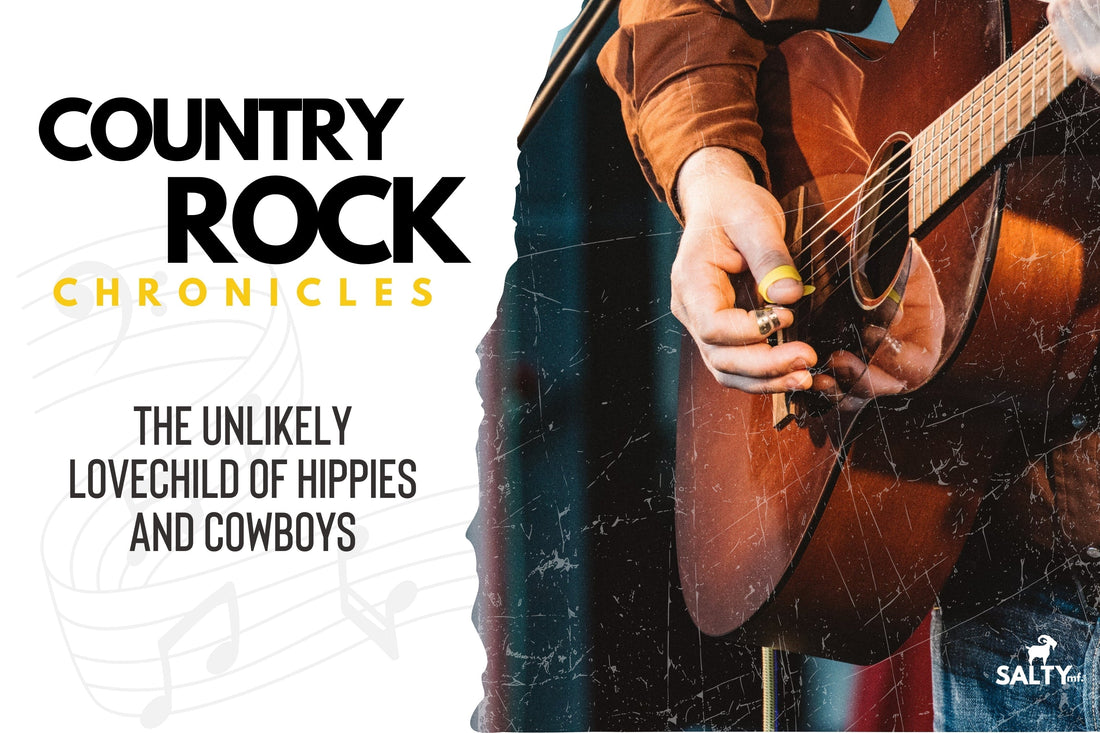
Country Rock Chronicles: The Unlikely Lovechild of Hippies and Cowboys
Cultural Rifts of the Vietnam War
Throughout the 50s, 60s, and 70s, America saw its unity shattered by conflicting views on military involvement in Vietnam, giving rise to a powerful musical movement that shaped culture and voiced the era's deep political rifts.
In a tumultuous 1966, the sounds of antiwar sentiment echoed across America. Among those voices, U.S. veteran Kris Kristofferson's song "Vietnam Blues" resonated with many, offering a reflective perspective on the protesters and military service; he was a solitaire advocating an anti-war yet pro-veteran stance.
The Nashville music scene had its own reactive symphony. Mainstream artists like Marty Robbins responded to the protestors with songs like "Ain't I Right," branding them as communist allies. A host of other artists - Ernest Tubb, Loretta Lynn, Stonewall Jackson, Bill Anderson, and others added their distinct notes to the unfolding narrative. Even Willie Nelson made his statement with his 1968 antiwar single "Jimmy's Road," which struck a different chord within the music community.
Back in these days, country music was closely associated with traditional values and often seen as conservative. In contrast, the edgy sound of rock music appealed more to the free-spirited youth, who were sometimes labeled as rebellious and anti-establishment. The fusion of these seemingly opposite worlds led to the birth of a new genre—country rock.
This article aims to explore how the combination of country and rock music during a pivotal time in American history birthed a dynamic and enduring genre that ultimately connected those on both sides of the cultural and political spectrum.
The Seeds of a Genre
A Blend of Sounds
Country was seen as corny and outdated by younger listeners, but for rockers, it was a tool to be used for constructing a whole new sound. Rock musicians, who's influence comes from early 1900s country music, yearned to pay respect to their country roots through the sound of their music. This combination allowed country rock to appeal to a wider audience, engaging fans of both genres and encouraging them to explore new musical horizons.
Understanding the roots of this genre means looking at how these two genres complement each other. The twang of acoustic guitars, banjos, and fiddles met the electrifying pulse of electric guitars and complex drum sets. Instruments like the pedal steel guitar became emblematic of country rock, adding a soulful depth to the music. Lyrically, the styles came together and evolved into a more personal expression that created the feeling of a more casual, conversational dynamic between singer and listener.

The Pedal Steel Guitar (via: WITF)
Early Pioneers and Geographical Hotbeds
Groups like The Byrds and artist Bob Dylan were instrumental in the genre's early inception. The Byrds’ 1968 album “Sweetheart of the Rodeo” is often cited as a seminal work in country rock history, challenging the boundaries of traditional country and rock at the time. Bob Dylan, with his folk background, brought lyrical depth to the genre, melding profound storytelling with rock rhythms.
Bob Dylan performs 'Blowing in the WInd' live on TV in March 1963
In the transformative decades of the 1960s and 1970s, the country rock music movement found fertile ground in three distinct regions.
Long revered as the epicenter of country music, Nashville played a pivotal role by grounding the movement in tradition. It was here that the authentic sounds of country were preserved and melded with new rock influences.
Meanwhile, Southern California became a mecca for innovation, where the fusion of rock and country elements flourished. The sun-soaked region provided a laid-back and eclectic backdrop that nurtured talents like The Eagles and The Byrds.
Widely regarded as the "Live Music Capital of the World," Austin, Texas emerged as a dynamic music scene that celebrated diversity and creativity. Artists such as Willie Nelson and Waylon Jennings found a welcoming home here, where they were free to experiment and blend various musical styles, further enriching the genre.
Together, these regions not only shaped the beginnings of country rock but also underscored its ability to evolve and resonate with listeners across generations.
Early Influences & Pioneers
Musical Roots and Influential Figures
Country rock drew its distinct sound from a multitude of genres, such as the blues, folk, rock, and country, each contributing its own flavor.
Known as "The King of the Blues," B.B. King was a legendary guitarist and singer who dominated blues music for decades. He was notorious for his unique guitar style, characterized by fluid string bending and shimmering vibrato, the likes of which found its place in country rock.

B.B. King plays to a prison crowd in Norfolk, VA (via: Achievment.org)
Howlin' Wolf, born Chester Arthur Burnett in 1910, was another central figure in the world of blues music. Wolf was a pioneer of the electric blues, a style that emerged in the post-World War II era, and he was essential in transforming acoustic "Delta blues" into the "Chicago blues"
Some of his most famous songs include "Smokestack Lightning," "Spoonful," and "Killing Floor," which have been covered by numerous artists across various genres. His influence is evident in the way country rock artists embraced bluesy guitar riffs, soulful vocals, and heartfelt lyrics, creating a genre that transcended the cultural boundaries of the time.
The Kingston Trio, a talented group who helped revitalize folk music in the 1950s, helped pave the way for artists like Bob Dylan. Their hit "Tom Dooley" brought folk music back to mainstream radio, influencing the lyrical and musical style of budding country rock artists.
The Rise of Rockabilly
The 1950s was a vibrant era for music, marked by the revolutionary emergence of rockabilly—an energetic blend of country, rhythm and blues, and rock and roll. This genre not only captivated a generation but also laid the foundational stones for what would become known as country rock.
The rockabilly days were spearheaded by iconic stars like Elvis Presley and Carl Perkins, whose groundbreaking sounds and energetic live performances brought this new genre to the main stage. Elvis, often hailed as the "King of Rock and Roll," infused his music with a unique blend of southern charm and raw rock energy.
His early hits like "That's All Right Mama" and "Blue Suede Shoes," originally penned by Carl Perkins, exemplified the rockabilly sound with their up-tempo beats and riveting guitar riffs. Elvis' charismatic stage presence and vocal prowess helped rockabilly reach a broader audience, transcending traditional genre boundaries.
Carl Perkins, another pivotal figure, contributed significantly to the development of rockabilly as well. While he may not have reached the colossal fame of Elvis, Perkins’s masterful songwriting and guitar playing skills left a lasting mark on the development of the genre. His knack for storytelling and integration of country melodies with rock rhythms played a crucial role in shaping the sound that would influence countless musicians.
A significant stage for rockabilly artists was that of the Grand Ole Opry, a revered venue in country music. Although initially resistant to the change, the Opry began hosting rockabilly acts, recognizing the genre's growing popularity and its resonance with younger audiences.
Icon Elvis Presley performs 'Money Honey' on stage in 1956
These performances were electrifying, blending the traditional with the new, and were met with both enthusiasm and skepticism from music fans. Some traditionalists viewed rockabilly as a departure from country music's pure roots, while others embraced its innovative nature and rebellious spirit.
The energetic style of rockabilly, characterized by its uptempo rhythms and amalgamation of musical genres, set the stage for country rock's emergence in the late 1960s and 1970s. Bands like The Byrds and musicians such as Gram Parsons drew inspiration from rockabilly's blend of country twang and rock intensity. They expanded on this foundation, crafting a sound that incorporated rock's electric guitar and backbeat with country music's storytelling and acoustic elements.
The Distinct Sound of Country Rock
Country rock is a captivating genre that blends the energy of rock with the heartfelt melodies of country. This genre's unique identity is characterized by a variety of musical elements, each inspired by traditions in rock, country, blues, and folk music.
The backbone of country rock lies in its instrumentation. The electric guitar, a staple in rock music, is used to infuse country rock with a vibrant edge. This versatility allows for everything from smooth, melodic solos to gritty, powerful riffs.
The pedal steel guitar, an ode to country music, adds a rustic layer of twang, often delivering the soulful, crying sounds that are a staple of the genre. The harmonica, with its roots in blues, contributes a raw, earthy layer, enhancing the musical narrative with a distinctly Americana feel.
Bands such as The Eagles and Lynyrd Skynyrd harnessed these instruments to craft their iconic sounds. The Eagles' "Hotel California" perfectly blends rock electric guitar solos with country-inspired melodies, while Lynyrd Skynyrd's "Sweet Home Alabama" highlights Southern rock influence through its powerful guitar riffs and rhythmic baselines.
Major Breakthroughs in Country Rock
A Concoction of Sounds
The music scene in the 1960s was captivating and ever-evolving. A remarkable movement began to take shape as folk musicians like The Byrds, Buffalo Springfield, and Bob Dylan started weaving country sounds into their music. This groundbreaking transition served as a catalyst for the birth of the country rock genre, a movement that would redefine the musical landscape of America.
Known for their complex harmonies and socially conscious lyrics, Buffalo Springfields began to dip their toes into country waters. Their music provided a rich soundscape that highlighted the expressive power of both styles. Songs like "Kind Woman," released in 1968, demonstrated this seamless integration, using country motifs to enhance their rock instrumentals.
Bob Dylan, ever the pioneer, infused his iconic storytelling with country nuances in his 1969 album "Nashville Skyline." His partnership with legendary country musicians brought a new depth to his music, introducing a lyrical sincerity and simplicity that echoed traditional country themes. Dylan's shift not only validated this fusion but also inspired many in the folk and rock worlds to explore similar paths.
As the 1960s unfolded, a new wave of musicians like Ricky Nelson and Gram Parsons joined in and took the country rock movement to unprecedented heights, solidifying it as a defining American genre. These artists, inspired by the pioneering sound of The Byrds, Buffalo Springfield, and Bob Dylan, embraced the fusion of country and rock, crafting music that resonated with authenticity and heartfelt storytelling.
Gram Parsons & The Fallen Angels performing live at Liberty Hall in Houston
Ricky Nelson, already a household name, saw the potential in this genre-blending style. His album "Bright Lights & Country Music" is a vivid illustration of his venture into country rock, where he skillfully wove country rhythms and instrumentation into his rock foundation.
Gram Parsons, often hailed as one of the fathers of country rock, was deeply influenced by the trailblazers before him. With his band, The Flying Burrito Brothers, and through collaborations like the album "Sweetheart of the Rodeo" with The Byrds, Parsons brought a fresh perspective to country rock. His work on albums such as "The Gilded Palace of Sin" seamlessly integrated country themes with rock's rebellious spirit, pushing the boundaries of both genres. Parsons' vision was deeply rooted in the authenticity and tradition of country music, yet he infused it with a modern, rock-inflected edge that captivated listeners.
Both Nelson and Parsons built upon the foundations laid by the likes of The Byrds, Buffalo Springfield, and Bob Dylan. They drew from the storytelling prowess and instrumental experimentation of these earlier artists, enriching the genre with their own distinct styles.
The Role of Iconic Venues
The Grand Ole Opry in Nashville, Tennessee opened its doors to the emerging sounds of country rock, offering artists an iconic stage to connect with audiences who cherished the roots of their music. The Opry hosted performances that resonated with the authenticity and tradition of country music while embracing the innovative spirit of rock. This blend of sounds on such an esteemed platform helped validate country rock as a legitimate genre and provided artists with a significant boost in credibility and reach.

The Grand Ole Opry in Nashvile, circa 1960s (via: Audiophile)
At the same time, the Troubadour in Los Angeles became a legendary haven for musicians experimenting with new sounds. Known for its intimate setting and supportive atmosphere, the Troubadour was a launchpad for many artists in the country rock scene. It was here that artists like Gram Parsons and The Flying Burrito Brothers delivered electrifying performances that captured the essence of this new musical direction. The venue's openness to musical styles allowed country rock to flourish, attracting audiences eager for something fresh.

These venues were more than mere performance spaces; they were crucibles of creativity where artists could hone their craft and gain exposure. These spaces also witnessed the blending of conservative bikers and liberal rockers, a rare occasion in those days.
Golden Days of Country Rock
Acceptance and Popularity
As the genre matured, it reflected the cultural paradigm of the era—one of transformation, exploration, and a yearning for connection. Country rock became a soundtrack for change, echoing the complexities of its time while inviting listeners to bridge divides through the universal language of music.
The Nitty Gritty Dirt Band was a pivotal force in this movement. Their 1971 hit rendition of "Mr. Bojangles" captured the essence of country rock, combining rich storytelling with instrumental dexterity. This track, along with their collaborative album "Will the Circle Be Unbroken," brought together diverse musical talents, celebrating the genre's roots and solidifying the sound within the music community.
The Nitty Gritty Dirt Band performing live with a cast of music legends
By the late 1960s into the 1970s, country rock had gained a more widespread acceptance. It transcended cultural barriers and resonated with a diverse audience. Even groups typically associated with rock n' roll, like The Beatles, drew inspiration from country elements to stamp their own mark on the genre.
Beatles albums of the time featured tracks that pulled from country rock influence. The group made their influence clear when they performed "Act Naturally" for a live audience.
Influential Artists and Bands
Perhaps no band is more synonymous with country rock than The Eagles. Formed in Los Angeles in 1971, The Eagles quickly soared to prominence with a sound that perfectly encapsulated the laid-back yet intricate style of Southern California.
Their harmonies, intricate guitar work, and powerful lyrics became the hallmark of their music. Albums like "Hotel California" and "Desperado" are not just records but major milestones in this genre's history,
With hits such as "Take It Easy" and "Tequila Sunrise" becoming timeless anthems, The Eagles' ability to weave narratives of the American experience through their music left an indelible mark on country rock, influencing millions and solidifying their place as legends in music.
A little further north, in the Bay Area, Creedence Clearwater Revival (CCR) was resonating with the southern roots of country rock. Led by the rustic, gritty vocals and songwriting of John Fogerty, CCR crafted songs that were both poignant and powerful.

Albums like "Green River" and "Cosmo's Factory" presented classics like "Bad Moon Rising" and "Fortunate Son," songs that combined rockabilly roots with swampy blues and a little country drawl. Their music was a melting pot of genres, reaching audiences across divides that other musicians could not.
On the opposite side of the country, near Jacksonville, Lynyrd Skynyrd was emerging from the deep south, and they brought a distinct southern flair to country rock. Known for their triple-guitar attack and raw, anthemic songs, Lynyrd Skynyrd captured the spirit of the south through their music.
Their 1973 debut album, "(Pronounced 'Lĕh-'nérd 'Skin-'nérd)," gave us timeless songs like "Simple Man" and "Free Bird," while "Sweet Home Alabama," from their follow-up album "Second Helping," became a defining anthem of the era a few years later. Lynyrd Skynyrd's music celebrated southern pride and resilience, making them icons of both country rock and southern rock for decades to come.
In 1972, Neil Young released his album "Harvest," which beautifully blended elements of rock and country, crafting a sound that tickled the ears of music listeners. Young's authentic voice and heartfelt lyrics resonated with audiences, creating an intimate connection through stories that felt personal yet universal. Songs like "Heart of Gold" and "Old Man" showcased his ability to weave narrative and melody into a tapestry that captivated listeners, securing his place in the pantheon of country rock stars.
Evolution & Modern Influence
Transition and Mainstream Integration
As the 1970s unfolded, Neil Young and his contemporaries continued to lay the groundwork for a sound that would eventually bleed into mainstream country music. The sonically pleasing fusion of rock's edge and country’s narratives became a blueprint for future artists.
Figures like Tom Petty and John Mellencamp drew inspiration from this synthesis, crafting music that carried the torch forward with a similar passion for narrative and innovation. The Turnpike Troubadours, too, embraced these roots, infusing their work with the authenticity and spirit that Neil Young helped popularize.
However, as the decade neared its end, the landscape was shifting. The late 1970s was personified by the pulsating beats of disco, the raw energy of punk, and the powerful riffs of metal which appealed to a new generation, leading to a decline in country rock's mainstream popularity.
Legacy and Continued Impact
Country rock's ability to transcend cultural boundaries and blend musical traditions laid the groundwork for future genres and musical exploration. The fusion of country and rock in the late 1960s created a vibrant new genre that not only captivated audiences but also paved the way for southern rock, a movement that would dominate the 70s and 80s.
Formed in 1969, the Texas trio—Billy Gibbons, Dusty Hill, and Frank Beard—brought a bluesy, boogie-infused rock sound to the forefront that paid homage to the country rock movement. In the 1970s and 1980s, ZZ Top released a series of best-selling albums that solidified their place in music history. "Tres Hombres" (1973) featured the hit "La Grange," a track that showcased their signature blend of blues rock and southern storytelling.
Even The Grateful Dead, known for their eclectic sound and stunning live performances, drew significant influence from the improvisational nature of country rock. Jerry Garcia, the band's iconic frontman, brought a rich blues background to the Grateful Dead's sound. His early immersion in blues shaped his guitar playing and contributed to the soulful depth of the band's music.

Creedence Clearwater Revival, circa 1960s (via: Grunge)
The genre's cultural influence was wide-reaching, uniting fans across social and political lines and showcasing music's unifying power during a time of substantial change and unrest.
Revival and Modern Stars
In more recent years, country rock has surged back into the spotlight, riding a wave of renewed interest and affection. This revival, humorously dubbed "ronky-tonk" by music media in 2020, recaptures the gritty, heartfelt essence of the genre's glory days while giving it a contemporary twist.
Artists like Zach Bryan, Whiskey Myers and most recently, Post Malone, stand at the forefront of this revival, encapsulating and redefining the sound for a new generation.
A Legacy That Endures
Country rock's evolution is a testament to music's ability to challenge cultural and political barriers. It united opposing demographics and left a lasting legacy that continues to inspire modern music.
For further exploration, enthusiasts can immerse themselves in curated playlists or discover documentaries that capture the essence of this influential period in music history. Whether you're a seasoned enthusiast or a curious music junkie, country rock and its colorful past awaits your exploration.




